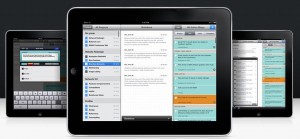Make no mistake about it; EXECUTION is what we are looking for from standard work.
If you execute, you can do anything. When a company has a clear mission, and people know how their individual mission fits into the big picture, everyone paddles in the
same direction. —Stephen Cooper
The biggest influence on my ability to execute has been Stephen Covey’s, The 7 Habits of Highly Effective People. It provided me a personal method to perform standard work. A later program developed by Franklin Covey was the The 4 Disciplines of Execution which I still listen to for reinforcement but without the context of the training, I would not necessarily recommend it. The actually four disciplines serve as a great guideline for execution:
- Focus on the Wildly Important: Human beings are wired to do only one thing at a time with excellence. The more we narrow our focus, the greater chance of achieving our goals with excellence.
- Create a Compelling Scoreboard: People play differently when they’re keeping score.
- Translate Lofty Goals into Specific Actions: To achieve goals you’ve never achieved before, you need to start doing things you’ve never done before. • Using an entrepreneurial
- Hold Each Other Accountable-All of the Time: Knowing others are counting on you raises your level of commitment.
These disciplines are what guides my own work and has allowed me to guide sales and marketing teams into higher levels of performance.
As I started my consulting path a few years back, I became a facilitator for the Get Clients Now – 28 Day Program. I always struggled with it somewhat because of the language used, appetizers, desserts, etc. but for the most part it provided a simple and concise action plan for assembling Wildly Important into Specific Actions into a Compelling Scoreboard (The Action Worksheet). When used with teams, it provides an excellent format for providing you a line of sight in daily stand-ups and weekly meetings. It was easily modified for individuals and organizations in Google docs for the teams that I was working with. As we all know, most sales efforts fall short in their ability to follow up which is at the core of the Get Clients Now Program. This outline became the core of standard work for my training programs.
Follow-through is the cornerstone of execution, and every leader who’s good at executing follows through religiously. Following through ensures that people are doing the things they committed to do. – Larry Bossidy
In my previous project management experience, I had found it was a matter of available resources that was the biggest inhibitor to actual execution. In most instances, thinking from a manufacturing or using GCN terminology a cook’s perspective, it was a missing tool or ingredient. When some has all the tools and/or material to do the job, they usually get the job done efficiently and at a high quality level. It holds true for sales and marketing. However, it always seemed to me that many action steps were started without the necessary resources available. The secret to what we needed to document in sales and marketing’s standard work was the needed resources to complete the action step and accept no workarounds.
In Scott Belsky’s (founder of Behance) book, Making Ideas Happen: Overcoming the Obstacles Between Vision and Reality, he uses an approach called The Action Method. which has become my management planner of choice. It is extremely simple and highly intuitive for a single person and/or team. I use the paper, online and the app for my iPhone all in combination with very little of redundant work. What the Action Planner does is creates a systems that emphasizes action steps and having the supporting resources available. This is the essence of standard work for the Lean Engagement Team. Making the resources you are utilizing and highlighting what you are missing to the rest of the team, Team Coordinator and Value Stream Manager is the single most important part of the Daily Standup and Weekly Tactical. It allows work to flow.
I have found that most organizations prefer to customize and many still use Google Docs as the reporting method of choice. However, the point is not what tool you use. The point is mastering it so it takes little effort to make your work visible to the rest of the team. This line of sight is what makes teamwork possible. Both of these methods require little if any experience and more importantly can be completed quickly.
The typical daily stand-up goes like this:
- State the action item and report did you do it: yes or no
- If not, what stopped you? Was a resource missing?
- What I am going to do today. Am I missing any resources? Who can help (if so, meet afterwards)?
The biggest problem I have had in these daily standups is that the managers have a tendency to turn them into longer sessions. They want to manage. The idea behind a daily standup is for tactical purposes. It is meant to enable team members to carry out their actions; nothing more, nothing less. Managers if they are participating should be enablers of the actions or in Lean terms the role of servant leadership.
P.S. The Action Planner resembles a simplified version of Kanban system such as the one offered by Lean Kit Kanban (my favorite online Kanban system).
Related Information
Even Seinfeld used Standard Work
Successful Lean teams are iTeams
The SDCA Cycle Description for a Lean Engagement Team
Evolutionary Change thru Kanban

